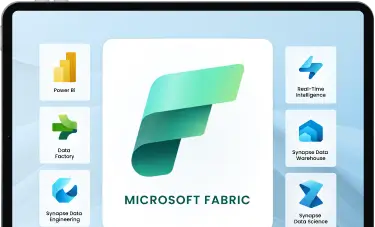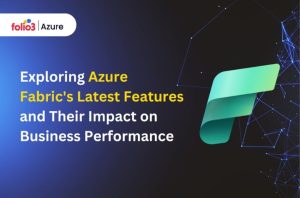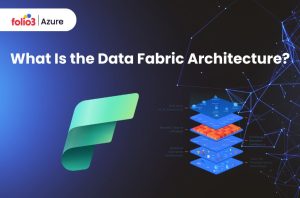Table of Contents
ToggleFor the modern data professional, the term “OneLake” within the expansive world of Microsoft Fabric might ring bells of innovation and utility. Yet, for the uninitiated, this term could be just another jargon in the fast-growing tech landscape.
Here, we will analyze in detail the profound significance of OneLake in Microsoft Fabric, clarifying its architecture, features, and benefits, ultimately shining a light on its crucial role in data management.
What is OneLake?
OneLake is Microsoft Fabric’s revolutionary approach to data lakes, designed to address the complexities that traditional data lake platforms encounter. It’s built to unify data lakes and data warehousing by combining large-scale data analytics with operational data, all within a singular environment.
The cornerstone of OneLake is its flexibility and scalability. It can handle structured, semi-structured, and unstructured data with ease, ensuring that data professionals can work with the full spectrum of data types without the need for multiple storage systems.
Importance of OneLake in Data Management
In the evolving landscape of data management, OneLake plays a vital role. By seamlessly integrating with the Microsoft Fabric ecosystem, it creates a single environment for data engineers and developers to process and analyze data. This unification leads to improved efficiency, as users can leverage consolidated tools and interfaces for tasks that once required complex setups.
OneLake is also pivotal in the democratization of data. It allows different teams to work within a shared environment without the data silos that often hinder collaboration and innovation. This encourages a culture where insights are accessible to all, driving informed decision-making at all levels of the organization.
Accelerate smart decisions with Microsoft Fabric's unified data and AI analytics.

Understanding OneLake Architecture
Core Components of OneLake
At the heart of OneLake’s architecture are three main components:
- Data Lake Store: Provides a scalable and durable repository for data of any type and size, allowing for high-performance analytics and batch processing.
- Data Management Service: Simplifies data management across various sources by providing a unified view, which is crucial for big data processing.
- Data Lake Analytics: An on-demand analytics job service that allows you to run big data queries on data stored in Data Lake Store or in Azure Blob Storage.
Integration With Microsoft Fabric Ecosystem
OneLake is not an isolated entity within the Microsoft universe. It integrates seamlessly with other services within the ecosystem, such as Azure Data Factory, Azure Databricks, and Synapse Analytics, providing a comprehensive platform for data engineering, data warehousing, and big data analytics.
Key Features and Capabilities
- Data Orchestration: Streamlines and automates data processing pipelines with serverless data orchestration.
- Data Governance: Ensures compliance and security with advanced monitoring, management, and governance capabilities.
- Data Exploration: Empowers users to explore data and build custom dashboards using familiar tools and languages.
Benefits of Microsoft Fabric OneLake
Here are the benefits of Microsoft Fabric OneLake:
1. Unified Data Management Platform
OneLake serves as a centralized platform for all data-related activities, which significantly reduces the complexity and cost associated with managing multiple data storage systems. Its unified approach makes data more accessible and manageable, ensuring that the organization can derive maximum value from its data assets.
2. Scalability and Performance Enhancements
With OneLake, the management of petabytes of data is made feasible through its cloud-native architecture. It offers unmatched scalability, adjusting to the data needs of your organization without compromising on performance. Additionally, it’s designed to enhance performance by leveraging distributed processing techniques.
3. Simplified Data Ingestion and Querying
One of the primary challenges in data management is data ingestion. OneLake simplifies this critical process, enabling data to be ingested from a variety of sources. Furthermore, it optimizes querying, allowing users to run complex data analytics workloads with speed and efficiency, regardless of the query complexity or data volume.
4. Integration with Azure Services
The tight integration of OneLake with Azure services means users can tap into a vast ecosystem that includes AI, machine learning, and IoT. This seamless blend of services provides an all-encompassing environment where diverse operations can be executed, further amplifying the utility and versatility of OneLake.
Ways to Access Microsoft Fabric OneLake
Below are the different ways to access Microsoft Fabric OneLake:
1. OneLake Data hub
The OneLake Data Hub serves as the primary interface for managing and interacting with OneLake. From here, users can create and manage data lakes, monitor tasks, and define access controls. It offers a holistic view of the data lake environment, ensuring comprehensive management.
2. OneLake file explorer for Windows
For a more familiar experience, Microsoft has provided a OneLake file explorer that allows Windows users to interact with OneLake as they would any other file system. This provides a convenient way to view and manipulate data within OneLake directly from the desktop.
3. URI
Accessing OneLake through Uniform Resource Identifiers (URIs) enables programmatic interaction, making it possible to query and retrieve data without manual intervention. It’s a powerful method for automation and integration with other applications.
4. API
OneLake comes with a robust API that offers programmatic access to its features. This means that developers have the flexibility to incorporate OneLake into bespoke solutions or automate routine tasks, thereby enhancing the productivity of their data workflows.
Conclusion
Microsoft Fabric’s OneLake represents a paradigm shift in the way we approach data management. By amalgamating the best of data lakes and data warehousing, it creates a powerful platform that can adapt to the growing demands of modern enterprises.
Its focus on scalability, performance, and accessibility underscores its importance in the data ecosystem. For businesses looking to capitalize on their data assets, OneLake in Microsoft Fabric is not just an option—it’s a necessity.




